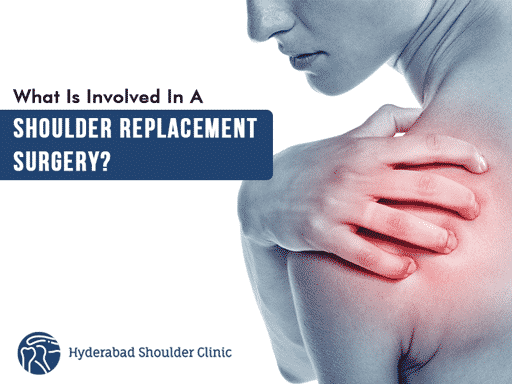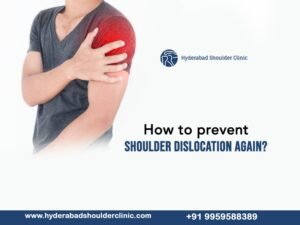Shoulder replacement surgery is a very successful procedure to relieve pain and restore mobility in patients suffering from end-stage shoulder arthritis and also, severe shoulder fractures. Pain, weakness, or stiffness of your shoulder can be caused by injury, overuse, or arthritis, but you don’t have to live with it. Shoulder replacement surgery can ease your pain and make your shoulder feel normal again. This procedure works for rotator cuff fractures and injuries due to arthritis and degenerative joint disorders. Although this can be tolerated with a few simple treatments, including medication and lifestyle adjustments, there may be times when surgical treatment is needed.
One year after surgery, 95% of patients have a painless shoulder function that allows them to train their shoulders to restore strength and movement. Most patients can play golf or tennis, swim, do yoga or pilates again, and do other physical activities that were not possible due to shoulder pain.
This article provided by Dr Chandrasekhar gives information about shoulder replacement surgery, and what is involved in a shoulder replacement surgery.
What is shoulder replacement surgery?

Another name for shoulder replacement surgery is shoulder Arthroplasty. It helps in the removal of shoulder joint parts that are replaced with artificial implants to relieve pain and restore rotational range and mobility. It has been very successful in treating severe pain and stiffness caused by end-stage arthritis.
Shoulder arthritis is a condition in which the delicate cartilage covering the shoulder bone is degenerated or damaged. In strong arms, these cartilage surfaces allow bones to glide comfortably with each other. When the surface of the cartilage disappears, the bones touch directly, which increases friction and causes them to tear and damage one another. Bone movements can be excruciating and difficult, and this artificial substitute surface restores painless motion, strength and function.
Which part of the shoulder is replaced?
The ball and socket are joints of the shoulder. The ball is the upper part of the arm bone and is called the humeral head. The socket is smaller and part of the shoulder blade. The ball is held in the socket band and the rotator cuff tendon. Rotator cuffs start at the shoulder blade and turn to tendons which attach to the ball. With shoulder replacement, the ball is replaced by a metal ball mounted on the stem. The stem is inserted below the humerus.
In order to hold the stem in place, cement is sometimes used. The sockets are sometimes replaced by plastic parts which are usually attached to grooves in the cement socket. Whether the socket is used or not depends on how bad the arthritis is on the shoulder and whether the rotator cuff tendon is still intact.
The most common type of shoulder replacement surgery:

Partial shoulder replacement: This operation is sometimes called hemiarthroplasty or resurfacing, and replaces the head or balls and sockets with metal balls. Even though the original cup is not replaced, your surgeon may need to smooth and reshape the socket to accommodate the prosthetic ball. This type of shoulder replacement is the most rarely performed for active young patients with arthritis or significant upper bone fractures.
Total shoulder replacement: This surgical procedure replaces the worn out and diseased joint surface. Like a partial shoulder replacement, the head or ball is replaced with a metal ball. Also, the socket is replaced by plastic components.
Reverse Shoulder Replacement: Like general shoulder anatomy replacement, both joint surfaces are replaced. But in this case, the position of the ball and socket is reversed. A metal ball is attached to the shoulder blade where the socket is, and a synthetic plastic socket is above the upper humerus where the ball was before. This arrangement is far more stable than the anatomic arm and does not require a rotator cuff for stability. Deltoid controls the movement of the arm instead of the rotator cuff.
What is involved in shoulder replacement Surgery?

In traditional shoulder surgery, damaged humers heads (ball joints) are replaced by metal balls, and the glenoid cavity (socket joint) is replaced with a smooth plastic cup. This metal-plastic implantation system is used for almost every shoulder replacement. In some patients, e.g.in patients with severe shoulder fractures, partial shoulder replacement (called hemireplasty) may be recommended. This technique only replaces the ball component. Let us see what is involved in the surgery.
Anaesthesia:
During shoulder replacement, patients can have regional anaesthesia with interscalene block or general anaesthesia or both. During surgery, the patient sits upright and wholly or partially sedated.
Traditional shoulder replacement surgery steps:
Conventional shoulder replacement surgery consists of the following six basic steps:
- To access the shoulder in a mostly nerve free area, the surgeon separates the deltoid and pectoral muscles (to minimize nerve damage).
- The shoulder is opened by cutting off one of the front muscles of the rotator cuff that covers the arm. This “opens the door” so the surgeon can see and manipulate the arthritic parts of the shoulder ball and the socket.
- Arthritic area of the joint removed.
- Components of the implant socket, ball and stem are inserted. The metal ball component is attached to a stem that extends downward in the patient’s humerus region.
- Inside the rotator, cuff incisions are closed and sewn.
- The outer incision is cleaned and sewn, and the dressing is applied as a temporary covering.
Minimally invasive shoulder replacement:
Minimally invasive is the term for all types of surgery that are less invasive than conventional or open surgery. Minimally invasive partial or total shoulder replacement surgery is an innovative procedure that is as effective as traditional surgery.
Minimally invasive shoulder procedures are common and are often recommended for many shoulder ailments, including surrounding ligaments, muscles, and tendons, in rotator cuff tear or pain or labral tear. The procedure is the same as open surgery, but small incisions are used. One incision is used for endoscope insertion (consists of a camera at the tip, which shows the image of the inner part on screen). By seeing that image, the surgeon can perform surgery with the use of other incisions.
Minimally invasive shoulder replacement offers results that are as successful as traditional surgery with larger incisions. It is made by smaller incisions, which allows faster recovery with the added benefit of more minor scars.
Recovery from a shoulder replacement?

Usually, it takes eight weeks or more for the patient to recover. It takes several months for patients to do heavy work or strenuous exercise.
On the day of the surgery
The patient wakes up in the recovery room with his arms immobilized to the side with a removable sling. Usually, patients experience temporary pain due to surgery, but this is not the same type of pain that they experience due to arthritis.
The day after surgery
X-rays are taken to determine whether the implant is inserted correctly. As soon as the patient gets the range of motion and stability with the implant, physical therapy begins on the same day. Usually, the patient immediately notices that the arm moves more efficiently, and there is no feeling of grinding.
The shoulder is immobilized by the sling during the initial rehabilitation phase so that the repaired tendon can heal. This sling can be removed for bathing and rehabilitation exercises. Mobility increases slowly with physiotherapy.
Conclusion:
Patients who have tried the usual treatment for shoulder arthritis but have not found adequate assistance can be candidates for shoulder replacement surgery. Patients considering the procedure must understand how shoulder replacement is performed, along with the risks of surgery. The goal of a joint replacement is to relieve pain rather than to increase strength.
For more information about shoulder joint replacement and to find out if you are a candidate or not, make an appointment with Dr Chandra Sekhar, an experienced shoulder surgeon. Please call at 9959588389 or contact us via a video consultation online appointment





